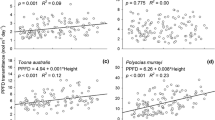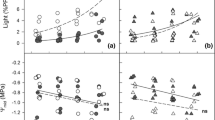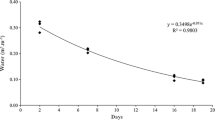Abstract
Although shade tolerance is often assumed to be a fixed trait, recent work suggests ontogenetic changes in the light requirements of tree species. We determined the influence of gas exchange, biomass distribution, and self-shading on ontogenetic variation in the instantaneous aboveground carbon balance of Acer saccharum. We quantified the aboveground biomass distributions of 18 juveniles varying in height and growing in low light in a temperate forest understory in Minnesota, USA. Gas exchange rates of leaf and stem tissues were measured, and the crown architecture of each individual was quantified. The YPLANT program was used to estimate the self-shaded fraction of each crown and to model net leaf-level carbon gain. Leaf respiration and photosynthesis per gram of leaf tissue increased with plant size. In contrast, stem respiration rates per gram of stem tissue declined, reflecting a shift in the distribution of stem diameter sizes from smaller (with higher respiration) to larger diameter classes. However, these trends were outweighed by ontogenetic increases in self-shading (which reduces the net photosynthesis realized) and stem mass fraction (which increases the proportion of purely respiratory tissue) in terms of influence on net carbon exchange. As a result, net carbon gain per gram of aboveground plant tissue declined with increasing plant size, and the instantaneous aboveground light compensation point increased. When estimates of root respiration were included to model whole-plant carbon gain and light compensation points, relationships with plant size were even more pronounced. Our findings show how an interplay of gas exchange, self-shading, and biomass distribution shapes ontogenetic changes in shade tolerance.






Similar content being viewed by others
References
Abramoff MD, Magelhaes PJ, Ram SJ (2004) Image processing with Image. J Biophotonics Int 11:36–42
Augspurger CK (2008) Early spring leaf out enhances growth and survival of saplings in a temperate deciduous forest. Oecologia 156:281–286
Azcón-Bieto J, Lambers H, Day DA (1983) Respiratory properties of developing bean and pea leaves. Aust J Plant Physiol 10:237–245
Baltzer JL, Thomas SC (2007) Determinants of whole-plant light requirements in Bornean rain forest tree saplings. J Ecol 95:1208–1221
Bazzaz FA (1979) Physiological ecology of plant succession. Annu Rev Ecol Syst 10:351–371
Connell JH, Slatyer RO (1977) Mechanisms of succession in natural communities and their role in community stability and organization. Am Nat 111:1119–1144
Delagrange S, Messier C, Lechowicz MJ, Dizengremel P (2004) Physiological, morphological and allocational plasticity in understory deciduous trees: importance of plant size and light availability. Tree Physiol 22:775–784
Duursma RA, Falster DS, Valladares F, Sterck FJ, Pearcy RW, Lusk CH, Sendall KM, Nordenstahl M, Houter NC, Atwell BJ, Kelly N, Kelly JWG, Liberloo M, Tissue DT, Medlyn BE, Ellsworth DS (2012) Light interception efficiency explained by two simple variables: a test using a diversity of small- to medium-sized plants. New Phytol 193:397–408
Falster DS, Westoby M (2003) Leaf size and angle vary widely across species: what consequences for light interception? New Phytol 158:509–525
Falster DS, Reich PB, Ellsworth DS, Wright IJ, Westoby M, Oleksyn J, Lee TD (2012) Lifetime return on investment increases with leaf lifespan among 10 Australian woodland species. New Phytol 193:409–419
Frazer GW, Canham CD, Lertzman KP (1999) Gap Light Analyzer (GLA), version 2.0: Imaging software to extract canopy structure and gap light transmission indices from true-color fisheye photographs, users manual and program documentation. Simon Frazer University/Institute of Ecosystem Studies, Burnaby/Millbrook
Givnish TJ (1988) Adaptation to sun and shade: a whole-plant perspective. Aust J Plant Physiol 15:63–92
Harrington RA, Brown BJ, Reich PB (1989) Ecophysiology of exotic and native shrubs in Southern Wisconsin: relationship of leaf characteristics, resource availability, and phenology to seasonal patterns of carbon gain. Oecologia 80:356–367
Knapp AK, Carter GA (1998) Variability in leaf optical properties among 26 species from a broad range of habitats. Am J Bot 85:940–946
Kneeshaw DD, Kobe RK, Coates KD, Messier C (2006) Sapling size influences shade tolerance ranking among southern boreal tree species. J Ecol 94:471–480
Lee TD, Reich PB, Bolstad PV (2005) Acclimation of leaf respiration to temperature is rapid and related to specific leaf area, soluble sugars and leaf nitrogen across three temperate deciduous tree species. Funct Ecol 19:640–647
Lopez OR, Farris-Lopez K, Montgomery RA, Givnish TJ (2008) Leaf phenology in relation to canopy closure in southern Appalachian trees. Am J Bot 95:1395–1407
Lusk CH (2004) Leaf area and growth of juvenile temperate evergreens in low light: species of contrasting shade tolerance change rank during ontogeny. Funct Ecol 18:820–828
Lusk CH, Jorgensen MA (2013) The whole-plant compensation point as a measure of juvenile tree light requirements. Funct Ecol 27:1286–1294
Lusk CH, Falster DS, Jara-Vergara CK, Jimenez-Castillo M, Saldana-Mendoza A (2008) Ontogenetic variation in light requirements of juvenile rainforest evergreens. Funct Ecol 22:454–459
Lusk CH, Perez-Millaqueo MM, Piper FI, Saldana A (2011) Ontogeny, understory light interception and simulated carbon gain of juvenile rainforest evergreens differing in shade tolerance. Ann Bot 108:419–428
Lusk CH, Perez-Millaqueo MM, Saldana A, Burns BR, Laughlin DC, Falster DS (2012) Seedlings of temperate rainforest conifer and angiosperm trees differ in leaf area display. Ann Bot 110:177–188
Machado JL, Reich PB (2006) Dark respiration rate increases with plant size in saplings of three temperate tree species despite decreasing tissue nitrogen and nonstructural carbohydrates. Tree Physiol 26:915–923
Mitchell KA, Bolstad PV, Vose JM (1999) Interspecific and environmentally induced variation in foliar dark respiration among eighteen southeastern deciduous tree species. Tree Physiol 19:861–870
Niklas KJ, Cobb ED (2008) Evidence for “diminishing returns” from the scaling of stem diameter and specific leaf area. Am J Bot 95:549–557
Niklas KJ, Cobb ED (2010) Ontogenetic changes in the numbers of short- vs. long-shoots accounts for decreasing specific leaf area in Acer rubrum (Aceraceae) as trees increase in size. Am J Bot 97:27–37
Niklas KJ, Enquist BJ (2001) Invariant scaling relationships for interspecific plant biomass production rates and body size. Proc Natl Acad Sci USA 98:2922–2927
Pacala SW, Canham CD, Silander JJA, Kobe RK (1994) Sapling growth as a function of resources in a north temperate forest. Can J For Res 24:2172–2183
Pearcy RW, Yang WM (1996) A three-dimensional crown architecture model for assessment of light capture and carbon gain by understory plants. Oecologia 108:1–12
Poorter L, Bongers F (2006) Leaf traits are good predictors of plant performance across 53 rain forest species. Ecology 87:1733–1743
Poorter L, Bongers F, Sterck FJ, Woll H (2003) Architecture of 53 rain forest tree species differing in adult stature and shade tolerance. Ecology 84:602–608
Pruyn ML, Gartner BL, Harmon ME (2002) Respiratory potential in sapwood of old versus young ponderosa pine trees in the Pacific Northwest. Tree Physiol 22:105–116
Reich PB, Tjoelker MG, Machado JL, Oleksyn J (2006) Universal scaling of respiratory metabolism, size and nitrogen in plants. Nature 439:457–561
Reich PB, Luo Y, Bradford JB, Poorter H, Perry CH, Oleskyn J (2014) Temperature drives global patterns in forest biomass distribution in leaves, stems, and roots. Proc Natl Acad Sci USA 111:13721–13726
Roderick ML, Farquhar GD, Berry SL, Noble IR (2001) On the direct effect of clouds and atmospheric particles on the productivity and structure of vegetation. Oecologia 129:21–30
Sendall KM, Reich PB (2013) Variation in leaf and twig CO2 flux as a function of plant size: a comparison of seedlings, saplings, and trees. Tree Physiol 33:713–729
Singsaas EL, Ort DR, DeLucia EH (2001) Variation in measured values of photosynthetic quantum yield in ecophysiological studies. Oecologia 128:15–23
Sterck FJ, Bongers F (1998) Ontogenetic chnages in size, allometry, and mechanical design of tropical rain forest trees. Am J Bot 85:266–272
Sterck FJ, Schieving F, Lemmens A, Pons TL (2005) Performance of trees in forest canopies: explorations with a bottom-up functional-structural plant growth model. New Phytol 166:827–843
Sterck FJ, Duursma RA, Pearcy RW, Valladares F, Cieslak M, Weemstra M (2013) Plasticity influencing the light compensation point offsets the specialization for light niches across shrub species in a tropical forest understory. J Ecol 101:971–980
Swanson L, Meyer GN (eds) (1990) Geologic Atlas of Washington County, Minnesota. Minnesota Geological Survey, St. Paul
Ter Steege H (1996) Winphot 5: a programme to analyze vegetation indices, light and light quality from hemispherical photographs. Tropenbos Guyana Reports. Tropenbos Guyana Programme, Georgetown
Teskey RO, Saveyn A, Steppe K, McGuire MA (2008) Origin, fate and significance of CO2 in tree stems. New Phytol 177:17–32
Thomas SC (2010) Photosynthetic capacity peaks at intermediate size in temperate deciduous trees. Tree Physiol 30:555–573
Tjoelker MG, Oleksyn J, Reich PB (1999) Acclimation of respiration to temperature and CO2 in seedlings of boreal tree species in relation to plant size and relative growth rate. Glob Change Biol 5:679–691
Tjoelker MG, Oleksyn J, Reich PB (2001) Modelling respiration of vegetation: evidence for a general temperature-dependent Q10. Glob Change Biol 7:223–230
Valladares F, Stillman JB, Pearcy RW (2002) Convergence in light capture efficiencies among tropical forest understory plants with contrasting crown architecture: a case of morphological compensation. Am J Bot 89:1275–1284
Walters MB, Reich PB (1996) Are shade tolerance, survival, and growth linked? Low light and nitrogen effects on hardwood seedlings. Ecology 77:841–853
Walters MB, Kruger EL, Reich PB (1993) Relative growth-rate in relation to physiological and morphological traits for northern hardwood tree seedlings—species, light environment and ontogenic considerations. Oecologia 96:219–231
Whitmore TC (1989) Canopy gaps and the two major groups of trees. Ecology 70:536–538
Acknowledgments
We thank Carrie Eberle and Jeanne Osnas for field assistance, and the staff at the St. Croix Watershed Research Station for logistical assistance. This work was supported by the Wilderness Research Foundation.
Author contribution statement
KMS and PBR conceived and designed the project. KMS conducted fieldwork, ran model simulations and analyzed the data. KMS, PBR, and CHL wrote the manuscript.
Author information
Authors and Affiliations
Corresponding author
Additional information
Communicated by Jeremy Lichstein.
Electronic supplementary material
Below is the link to the electronic supplementary material.
Rights and permissions
About this article
Cite this article
Sendall, K.M., Lusk, C.H. & Reich, P.B. Becoming less tolerant with age: sugar maple, shade, and ontogeny. Oecologia 179, 1011–1021 (2015). https://doi.org/10.1007/s00442-015-3428-x
Received:
Accepted:
Published:
Issue Date:
DOI: https://doi.org/10.1007/s00442-015-3428-x




